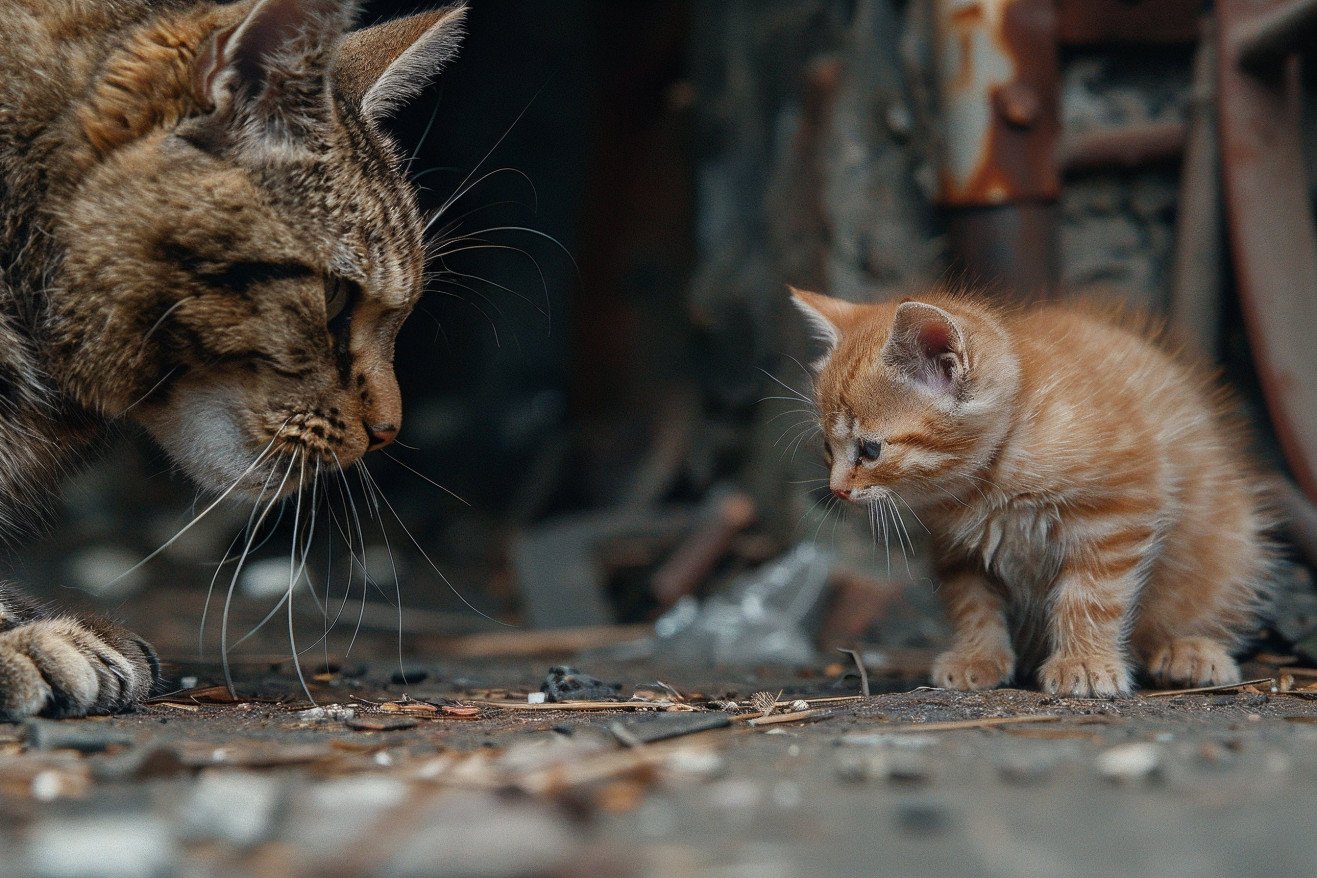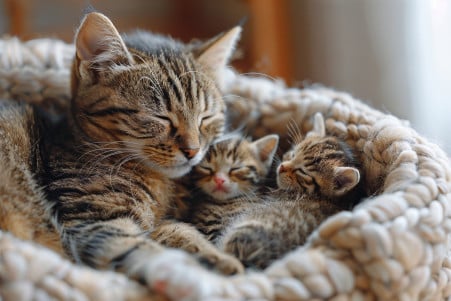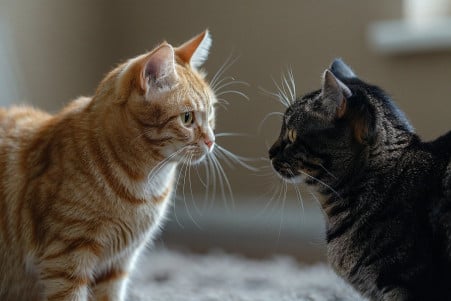Why Do Male Cats Kill Kittens? How to Stop Infanticide
15 April 2024 • Updated 15 April 2024

Why do some male cats exhibit the shocking behavior of killing kittens, and what can pet parents do to prevent this sad situation? Some male cats, especially those that are not neutered, may kill kittens because of an instinctual urge to get rid of potential rivals for mates and other needs. This risk can be lowered by neutering and by making sure male cats are properly introduced to and supervised around litters of kittens.
In order to get a complete picture of this phenomenon, we will look at studies from a variety of scientific disciplines, including evolutionary biology, animal behavior, and veterinary medicine. By exploring the factors that can lead to infanticide in male cats, you can learn how to prevent it and how to create a peaceful multi-cat home. Although it may be hard to read, this investigation will help you understand natural instincts and how pet parents can work to minimize potential problems.
Why do male cats kill kittens?
The Evolutionary Drive: Why Male Cats Kill Kittens
The phenomenon of male cats killing kittens is disturbing, but it is also deeply rooted in evolutionary biology and the instinctual drive to pass on their genes. As The Purring Journal points out, male cats in the wild would kill the kittens of other males to protect their territory and ensure their own genes were passed on. This is an instinct that some male housecats still carry with them.
Male cats see unrelated kittens as a threat, as they could grow up to compete for mates and resources within their territory. As MessyBeast.com explains, male cats use scent to determine paternity. If they smell a male other than themselves on kittens, they may kill them to prevent those kittens from passing on the other male's genes.
This is not an act of cruelty, but rather an evolutionary adaptation that has been shaped by natural selection over thousands of years. According to research cited on Pets Stack Exchange, the presence of male sex hormones like testosterone directly stimulates the infanticidal drive. By killing potential rivals early, male cats increase their chances of being able to mate and produce offspring that will carry their genes.
Hormones and Neutering in Preventing Infanticide
The connection between male sex hormones, especially testosterone, and the killing of kittens is clear. As Pets Stack Exchange notes, male sex hormones are a major cause of the infanticidal behavior seen in male cats. However, neutering a male cat can lower testosterone and reduce the likelihood of this behavior.
The Cornell University College of Veterinary Medicine says the first step in dealing with male cat aggression is to neuter or spay all the cats involved because sex hormones are so important. The Purring Journal also points out that neutered male cats are much less aggressive around kittens and less likely to show the evolutionary behaviors that lead to killing them.
In addition to preventing unwanted kittens, neutering can help create a more peaceful multi-cat home. Although some people may worry about neutering, professionals stress that it's important to do to reduce the risk of infanticide and make sure all cats in the home are safe.
Maternal Aggression: When Female Cats Kill Their Own Kittens
Although this article has mainly discussed the upsetting behavior of male cats killing kittens, it is also important to talk about maternal aggression and filicide in female cats. According to research on maternal behavior problems in cats, there are a number of reasons why female cats may show aggression toward and even kill their own kittens.
Maternal inexperience, hormonal issues, stress, and birth defects in the kittens are all factors that can lead to a mother cat killing her kittens. Cat-World notes that even if a kitten seems healthy, it could have congenital issues that aren't immediately visible that cause the mother to focus on the healthier kittens. Maternal neglect, as opposed to aggression, can also lead to the death of kittens.
While the evolutionary reasons for male cats' infanticidal behavior are different than those for maternal aggression, there are some parallels. Like male cats, the Cornell University College of Veterinary Medicine says that it's important to watch queens with newborn kittens closely and consult a vet if problematic behaviors continue.
How to Introduce a Kitten to an Older Male Cat: Step-by-Step
Introducing a kitten to a home with an older male cat will take time, effort, and a lot of patience. According to Hill's Pet, the process should start before the kitten even arrives by helping the older cat get used to the new sights, sounds, and smells that the kitten will bring into the home. This can be done by placing the kitten's bedding around the house so that the older cat can get used to the new smells.
When the kitten arrives, it's important to keep the two cats separated at first, allowing them to get used to each other's presence through a physical barrier like a baby gate. Vets4Pets also suggests using pheromone diffusers to help keep both cats calm during the process. Gradually increase the amount of time the cats spend together, making sure to supervise them closely for any signs of stress or aggression.
As the Feliway blog points out, it's important to make sure that there are plenty of resources like food, water, litter boxes, and toys in different areas of the home to ensure that the cats don't feel like they have to compete for these things. With time and a careful introduction, the older male cat can eventually learn to accept the kitten as a member of the family. If you're still having trouble, don't hesitate to reach out to a vet or animal behaviorist for help.
How to Spot Aggressive Behaviors in Male Cats
Knowing the signs of aggression in male cats can help you prevent a tragedy before it happens. According to VCA Animal Hospitals, the first sign of aggression in a cat is often a fast side-to-side movement of the tail, coupled with the ears going back and the pupils dilating.
Meanwhile, Catster notes that a male cat's natural instinct is to kill kittens that aren't his own, as this will give him the opportunity to mate with the mother and ensure his genes are passed on. The Dumb Friends League also points out that territorial aggression, which is when a cat feels his territory and resources are being threatened, can be displayed with behaviors like chasing, ambushing, hissing and swatting.
Owners should also be on the lookout for signs of offensive aggression, including a stiff, upright body, stiff, straight rear legs, and a direct stare, or defensive aggression, including crouching, ears flattened, and hissing. In both cases, the ASPCA notes that it's important to avoid provoking an aggressive cat and give them space to calm down. If you notice any of these behaviors, especially if they continue or worsen, it's best to consult with a vet or animal behaviorist.
Conclusion: How to Encourage Healthy Multi-Cat Households
The key to preventing infanticide and encouraging healthy multi-cat households is to understand the evolutionary and hormonal reasons behind why male cats exhibit this behavior. Male cats, especially those that haven’t been neutered, are likely to kill unrelated kittens because they are hardwired to eliminate potential rivals and ensure their own genetic success.
Neutering male cats will lower their testosterone levels and reduce this behavior. Experts also stress the importance of slow, supervised introductions when bringing a new kitten into a home with an adult male cat. It’s also important to watch for early signs of aggression, including rapid tail movements and dilated pupils, so that you can intervene before it’s too late.
While the evolutionary reasons for this behavior are disturbing, responsible pet ownership and a little bit of planning can ensure that all the cats in your household are safe and happy. By understanding the reasons behind the behavior and taking steps to prevent it, you can ensure that your cats live together in peace and prevent the loss of innocent kittens.


